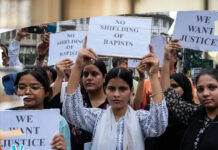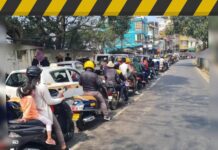In recent months, US Customs and Border Protection (CBP) has significantly increased its efforts to intercept counterfeit goods entering the country. This heightened vigilance has resulted in the confiscation of numerous fake luxury items from travellers, particularly affecting many Indian students and visitors.
The CBP regulations allow individuals to carry only one counterfeit item of each type for personal use, and exceeding this limit can lead to severe penalties and the loss of valuable belongings.
CBP’s Intensified Efforts to Combat Counterfeit Goods
The US Customs and Border Protection has intensified its efforts to curb the smuggling of counterfeit products into the country. This initiative comes in response to the alarming volume of counterfeit goods being intercepted.
In 2023 alone, CBP seized 23 million counterfeit items from nearly 20,000 shipments, with an estimated value of $2.7 billion if these goods had been genuine. The agency underscores that counterfeit goods pose a significant threat to economic vitality, national security, and public safety.
A representative from CBP explained that the influx of counterfeit goods not only violates Intellectual Property Rights (IPR) but also supports various criminal activities, including forced labour and human trafficking. The agency’s efforts aim to protect consumers and uphold the integrity of legitimate businesses.
Personal Accounts of Confiscation Experiences
Several travellers have shared their experiences of having counterfeit items confiscated by CBP officials. A schoolteacher from Jamshedpur, Jharkhand, recounted her ordeal when she travelled to Texas to visit her son.
Carrying eight shirts, four trousers, socks, and a pair of shoes, she was stopped by officials who confiscated her goods after determining they were counterfeit. “I lost goods worth at least Rs 30,000,” she lamented, highlighting the need for better awareness of these regulations.
Similarly, a 27-year-old student from Hyderabad studying in California faced a similar situation. Unaware of the rules, he had multiple items seized and discarded by customs officials.
“It is very common in India to buy copies of big brands. I had no idea it was a serious offense to carry them in my luggage,” he explained, emphasizing the lack of clear information available to travellers.
Under CBP regulations, individuals are permitted to carry only one counterfeit item of each type for personal use, such as one shirt, handbag, or pair of shoes. Any quantity exceeding this limit is strictly prohibited. This rule aims to prevent the importation of counterfeit goods for commercial purposes, which could undermine legitimate businesses and the economy.
Travellers unaware of these regulations often find themselves in difficult situations at ports of entry. The confiscation process can be both financially and emotionally distressing, as officials may destroy the counterfeit items on the spot. Many travellers, including students and visitors, have urged authorities to provide clearer guidelines and prominently display these rules to prevent such incidents.
Read more: ED VoxPop: We Asked GenZ Whether They Buy Dupes
Economic and Security Implications
The CBP’s stringent measures are part of a broader effort to protect the US economy and national security. Counterfeit goods, if allowed into the market, could severely impact legitimate businesses by flooding the market with cheaper, low-quality alternatives. This not only harms brand reputation but also reduces the revenue of genuine manufacturers.
Moreover, the sale of counterfeit goods is often linked to various criminal activities. The revenue generated from these sales can fund organized crime, including forced labour and human trafficking. By intercepting counterfeit goods, CBP aims to disrupt these illegal activities and safeguard public safety.
Many travellers have called for improved communication regarding the rules on counterfeit goods. The lack of clear and accessible information has led to numerous incidents where travellers inadvertently violate regulations, resulting in the confiscation of their belongings.
Both the schoolteacher from Jamshedpur and the student from Hyderabad emphasized the need for authorities to prominently display these rules on relevant platforms.
To avoid such situations, travellers are advised to educate themselves on the regulations before packing their bags. Understanding the limitations and restrictions on counterfeit goods can help prevent the loss of valuable items and potential legal repercussions.
The US Customs and Border Protection’s increased scrutiny of counterfeit goods underscores the importance of adhering to regulations and being aware of what can be carried into the country.
While the efforts aim to protect the economy and public safety, they also highlight the need for better awareness among travellers. By staying informed and cautious, travellers can avoid the pitfalls of carrying counterfeit items and ensure a smooth entry into the United States.
Image sources: Google Images
Feature Image designed by Saudamini Seth
Sources: Business Standard, Economic Times, Times of India
Find the blogger: Katyayani Joshi
This post is tagged under: Travel Alert, US Customs, Counterfeit Goods,, Luxury Brands, Travel Tips, CBP Regulations, Travel Safe, Indian Travelers, Fake Goods, Customs Crackdown, Intellectual Property, Brand Protection, Travel Awareness, US Border Control, Fake Fashion, Travel Advice, Customs Seizure, Nike, Adidas, Gucci, Puma, Know Before You Go, Travel Smart, Global Travel, Counterfeit Crackdown, US Immigration, Travel Warnings, Luxury Counterfeits, Customs Regulations
We do not hold any right over any of the images used, these have been taken from Google. In case of credits or removal, the owner may kindly mail us.
Other Recommendations:
This AI Can Tell You If Your Branded Purchase Is Real Or Fake



































